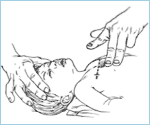INFANT/CHILD CHEST COMPRESSIONS
The universal rate for compressions in all cardiac arrest victims (adult, child, or infant) is 100 to 120 per minute. Likewise, the compressions-to-ventilation ratio for 1 rescuer (30:2) is the same for adult, child, and infant victims. For 2 rescuers, the compressions-to-ventilation ratio for adult, child or infant is 15:2.
Chest compression technique
Chest compression technique for most children is the same as for adult victim: 2 hands (heel of one hand with the heel of the other hand on top of the first hand). For a very small child, 1 hand may be used as long as the compression depth is at least 1/3 of chest diameter, or about 2 inches (5 cm)
When you give chest compressions:
- compress, rapidly, at a rate of 100 to 120 compressions per minute
- compress the chest hard, at least 2 inches (5 cm)
- allow the chest to recoil fully after each compression
- minimize interruptions in compressions
Do not move victim unless he is face down, appears to be in imminent danger, or on a soft or otherwise unsuitable surface such as a bed or bathtub.
Child chest compressions
- the child must be face up on a firm, flat surface. If you must move or roll them over, be extremely careful if you suspect head or neck injury
- stand or kneel at the victim’s side
- position your hands and body to perform chest compressions:
- place the heel of one hand in the center of the victim’s chest, on the lower half of the breastbone (sternum)
- place the heel of your other hand on top of the first hand
- straighten your arms and position your shoulders directly over your hands
- begin chest compressions at a rate of 100 to 120/minute (to the tune of Staying Alive)
- Press fast and hard, at least 1/3 of chest diameter (about 2 inches or 5 cm), making sure you push straight down on the victim’s breastbone
- at the end of each compression, allow the chest to recoil completely
Infant chest compressions
- the infant must be face up on a firm, flat surface. If you must move or roll them over, be extremely careful if you suspect head or neck injury
- place 2 fingers in the center of the infant’s chest, just below the nipple line – do not press the tip of the breastbone
- give compressions at a rate of 100 to 120/minute

- compress at least 1/3 of the chest diameter (about 1 ½ inches or 4 cm)
- At the end of each compression make sure you allow the chest to fully recoil.
- After every 30 compression open the airway with a head tilt-chin lift and give 2 breaths, each over 1 second. You should see the chest rise with each breath
- after 5 cycles or about 2 minutes of CPR, activate ERS and retrieve AED
- continue CPR and use the AED until ERS arrives